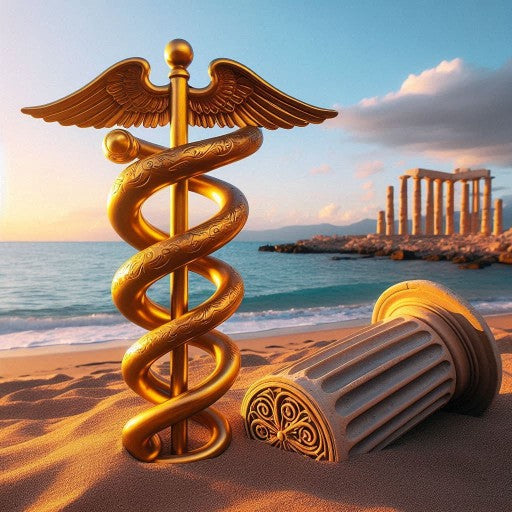Kos, part of the Dodecanese island group, is renowned for its beautiful landscapes, historical ruins, and deep connections to Greek mythology. The island has been a crossroads of myth, medicine, and culture, making it a fascinating destination for history enthusiasts and mythology buffs alike.
Table Of Contents
- Introduction to Kos and its Mythological Significance
- Divine Encounters on Kos
- Legendary Kings and Mythical Events
- Healing Temples and Ancient Medicine
- Mythological Creatures and Heroes
- Kos in the Trojan War
- Cultural Syncretism on Kos
- Archaeological Sites on Kos
- Conclusion
Divine Encounters on Kos
Heracles and His Adventures

Hercules And The Lernean Hydra
One of the most famous mythological figures associated with Kos is Heracles (Hercules). According to legend, Heracles was blown off course to Kos during one of his labors. Mistaken for a pirate by the islanders, he was initially attacked but soon subdued them. Heracles had a son, Thessalos, with the daughter of a local king, and his descendants, known as the Heracleidae, were said to have settled and ruled parts of the Dodecanese, including Kos.
Worship of Hera and Demeter


Symbols Of Demeter Symbols Of Hera
Kos was home to significant sanctuaries dedicated to Hera, the queen of the gods, and Demeter, the goddess of the harvest. These deities were central to the island's religious practices, reflecting the importance of fertility and agriculture in the local culture.
Legendary Kings and Mythical Events
King Merops and His Transformation
King Merops, a legendary ruler of Kos, was transformed into an eagle by the gods. This myth underscores the island's deep connections to the divine and its rich mythological traditions.
Polycaon and Messene
The myth of Polycaon and Messene tells the story of their journey from Kos to the Peloponnesian region of Greece, where they established the region known as Messenia. This legend highlights the island's influence beyond its shores.
Healing Temples and Ancient Medicine
The Asclepieion of Kos
The Asclepieion, an ancient healing temple dedicated to Asclepius, the god of medicine, was one of the most important medical centers in the ancient world. Pilgrims came to the Asclepieion seeking cures and divine guidance, often through dreams where Aesculapius (the Roman name for Asclepius) would visit them.
Hippocrates and the Tree of Learning
Hippocrates, the "Father of Medicine," was born on Kos and is believed to have taught his students under the famous plane tree, known as Hippocrates' Tree. This semi-mythical symbol highlights the island's profound influence on ancient medicine.
Mythological Creatures and Heroes
Chrysaor and the Blood of Medusa
Chrysaor, a giant born from the blood of Medusa when Perseus beheaded her, is sometimes linked to Kos. Chrysaor is depicted as a warrior, and his birth adds to the island's rich mythological narrative.
The Gigantomachy Connection
The Gigantomachy, the epic battle between the giants and the Olympian gods, has ties to Kos. Myths suggest that the blood of the defeated giants fell on the island, giving rise to various mythical creatures.
Kos in the Trojan War

The Trojan Horse
Kos contributed ships to the Greek fleet during the Trojan War, tying the island into the larger epic narratives of ancient Greece. This connection underscores Kos's strategic and mythological importance.
Cultural Syncretism on Kos
Kos was a melting pot of different cultures and beliefs, especially during the Hellenistic period when it was an important center of learning and culture. This cultural syncretism blended local myths with those of other regions, enriching the island's mythological heritage.
Archaeological Sites on Kos
Ancient Agora
The Ancient Agora of Kos is a significant archaeological site that offers insight into the island's commercial and social life in antiquity. This bustling marketplace was a center of activity, featuring temples, public buildings, and shops.
Roman Odeon
The Roman Odeon is a well-preserved theater that showcases the architectural prowess of the Romans. It was used for musical performances, theater, and political gatherings, reflecting the cultural blend of Kos.
Casa Romana
Casa Romana, a restored Roman villa, offers a glimpse into the luxurious lifestyle of Kos's ancient inhabitants. The villa is adorned with beautiful mosaics and frescoes, illustrating the artistic influence of the Roman era.
Castle of Neratzia
The Castle of Neratzia, built by the Knights of St. John, stands as a testament to Kos's strategic importance through the ages. Overlooking the harbor, this fortress provides a panoramic view of the island's history and its role in various conflicts.
Conclusion
Kos's mythological heritage is a tapestry of divine encounters, heroic deeds, and ancient healing practices. From Heracles and the Asclepieion to the legendary kings and mythical creatures, the island's stories continue to captivate and inspire. Coupled with its rich archaeological sites, Kos offers a unique and enriching experience, blending history, myth, and culture in a truly remarkable way.

